Last modified on March 24th, 2020 at 11:24 am
How to Use a Tomahawk: Prepare Yourself for the Outdoors
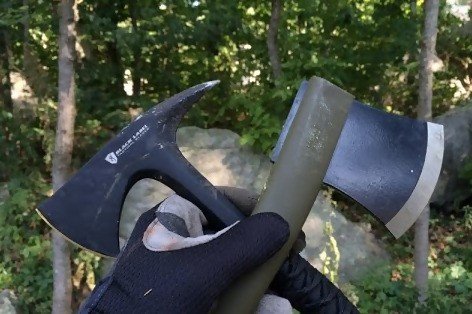
Article written by William Brown from Camp4
We’ve all seen those movies when someone dies with a tomahawk in the back. The most famous example being The Patriot, starring a middle-aged Mel Gibson. But is it a true representation of how to use a tomahawk? Or are the methods on the screen pure fiction?
This is what we are here to find out. First of all, a bit of history about the tomahawk. It is richly woven into the fabric of North America. Just a side note, before buying a tomahawk, make sure that you’ve done your research in your quest to find the best tomahawk available that will suit your needs.
Tomahawk History
The word tomahawk is derived from the original Algonquin words: Tamahakan and Tamahak. They were made by attaching chipped stone heads to wooden handles, fastened with rawhide strips. The Native American Algonquin tribes used tomahawks for chopping, cutting, and hunting; but most of all, they were weapons.
When Europeans made contact in the 1600s, the stone heads were changed up for metal blades. By this time, tomahawk use had spread to many tribes across North America, and warriors had become extremely proficient at using them in battle.
Metal tomahawk heads were further modified by the addition of a spike or hammer on the poll (opposite side of the blade). Then some genius came up with the idea of turning the poll side into a small bowl and hollowing out the inside of the handle so it could be used to smoke tobacco. Turning the tomahawk into the first multi-purpose device in the world ensured the tomahawk became standard bartering fare for American and Europeans at that time.
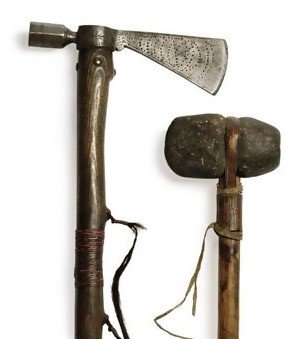
The 1700s to Today
The Continental Army required recruits to carry a tomahawk or a sword as part of their uniform because guns and ammo were so unreliable in those days. Even when gun manufacturing made them more accessible to large armies, a few American soldiers still preferred to use tomahawks in combat. They were perfect for the silent, deadly, hand to hand skills required in WWII and Korea.
Tomahawks continued to stay in the public eye when a Mohawk war veteran called Peter La Gana designed and crafted highly desirable tactical tomahawks around the time of the Vietnam War. Originals are rarely found on sale today, but La Gana Cold Steel Hawks are instantly recognizable because of the spike and Army Green camouflage coloring.
In today’s modern age where camping is quite popular, refrain from using them as part of creating fun as there are many other safe ways to make camping fun for the whole family.
What Should I Look for When Buying a Tomahawk?
There are a lot of tomahawk brands on the market, but not many that cater specifically for throwing. If you are buying your hawk for competitive throwing and practice, you should only be looking at brands that have been crafted exclusively for that purpose.
- Balanced for throwing
- Sized and designed for throwing
- Sharpened for throwing
If you don’t get a throwing tomahawk, you will find yourself stuck with one that has a more universal purpose such as survival and camping, and this will make it harder for you to practice.
What Size Tomahawk Should I Get?
| Age Recommendations | Size & Length |
| 12 years and under | Small hawks 16”/40.6cm |
| Young adults & women | Medium 18”/45.7cm |
| Men | Large 19”/48cm and up |
What is the Difference Between a Throwing Tomahawk & a Throwing Axe?
Both weapons date back to over 6000 years ago and have remarkable similarities.
- Weight: 1 to 3 lbs/0.45 to 1.3 kgs with 15-20 inch/38-50 cm handles
- Both used for hunting, defense, and target throwing
- Both thrown from the pitcher’s stance (forward leg is the opposite of the throwing arm)
- Typically made with one blade
The main difference between the two weapons is the way the head is inserted into the handle, and the technique used to do it. As you can see from the diagram (1), the hawk’s appearance is more aerodynamic and elegant. Tomahawks have always been seen as weapons first, and a useful instrument second. Whereas, the opposite is true for axes. The chances are that someone who has never thought about competitive hawk throwing will still have an axe in their shed.
Axes derive much of their effectiveness from geometry and mass. Hawks, however, are lethal and efficient because of the speed that comes from the narrow, long design.
Tomahawk Throwing Safety Tips
- Never throw in the direction of a target you don’t want to hit
- Never stand behind someone who is preparing to throw a hawk
- Never target a surface that can splinter or cause the hawk to ricochet
- Sheath your hawk before handing it to someone
- Remember to always place your hawk on a flat surface
- Inspect your hawk closely before first use every time
- Handle, practice, and store your weapon away from pets and children
How to Practice Throwing With a Tomahawk
Stance: A one handed hawk throwing stance (pitcher’s stance) is usually with the opposite leg to the throwing arm forward. The action and familiarity should be the same as that which you use to throw a ball. See diagram 2.
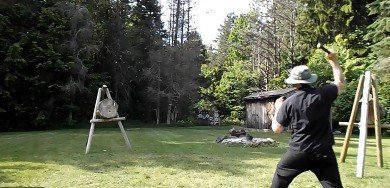
Grip: Hold your hawk the same way you would a hammer with the thumb at the handle side and the fingers wrapped around. The hawk should be cutting edge down.
Release: Point your hawk (cutting edge still down) and fully extend your throwing arm towards your intended target to aim. Then raise your arm fluidly over your shoulder without bending or straightening the elbow completely. A slight crook in the arm is just right. Swiftly bring your arm down to the position horizontal to the ground while simultaneously releasing the weapon. At the moment of your release, your hand should let go and resemble the position of someone offering a handshake.
Do’s & Don’ts of Tomahawk Throwing
Do
- Set up a good hawk block as a target.
- “Shake hands with your hawk.” The grip should be that of a person about to shake hands and grip the hand.
- Make sure the hawk head doesn’t rotate left or right. If you tilt it, your hawk will wobble when released.
- Place your thumb gently on top of the hawk handle to counteract any spin.
Don’t
- Never twist your wrist as it will send your hawk out of your release sideways.
- Don’t overuse your wrist instead of your arm. Minimum wrist action and mostly arm motion is how to learn fastest.
- Don’t throw too hard in the beginning. Learn the technique first.
- Don’t use a blunt hawk.
- Never use a ceremonial hawk-pipe for target practice.
- Don’t forget to let go!
If the hawk throwing bug bites you deep, you might want to look into some of the official requirements for hawk throwing in competition. Remember that every league championships will have their own rules, but in general, you will see these regulations in almost all of them.
- i. Every throw must be accomplished from an “arm/s overhead” stance. One or both hands can be used in the stance. A two-arm throw will have your dominant hand above the other one.
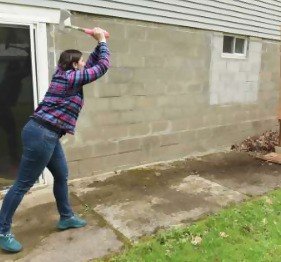
- ii. There must be at least 1 rotation of the tomahawk in the air before it hits the target.
- iii. Thrower should be standing at least 12’/3.6m away from the target.
- iv. Prepare for your hawk to be closely inspected before the competition to see if it is within the guidelines. This means your blade has to be sharp enough to stick into the target easily, but not razor sharp to the touch.
Throw Variations
A standard throw (whether you use one arm or two) results in the hawk making one revolution. If you move further back from the target, you will be able to get two rotations from the weapon before it buries itself into the target. By standing 5’/1.5m further than the standard distance, and holding the hawk with the cutting edge upward (see Diagram 3), the weapon will make one and a half rotations before hitting the target.
The more you practice with your throwing technique, the better control you will develop.
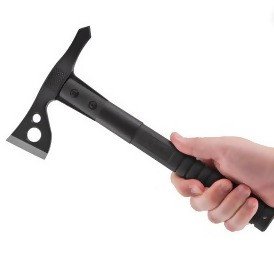
Is it Possible to Kill Someone Using a Tomahawk Like in the Movies?
No hawk use instruction manual would be complete without answering this question. And the answer is a most definite and emphatic “YES,” and with surprisingly little effort. The hawk’s powerful combination of weight, speed, force, and sharpness is easily enough to kill a person.
A throw would be especially deadly when aimed at the head area, as the muscles and ribcage are designed to protect the heart and lungs. But even a moderate strength hawk throw to the chest will penetrate a good couple of inches. These are weapons, very successful weapons, which is why they have been used in battle for thousands of years, and why the U.S. army still trains soldiers in its use.




